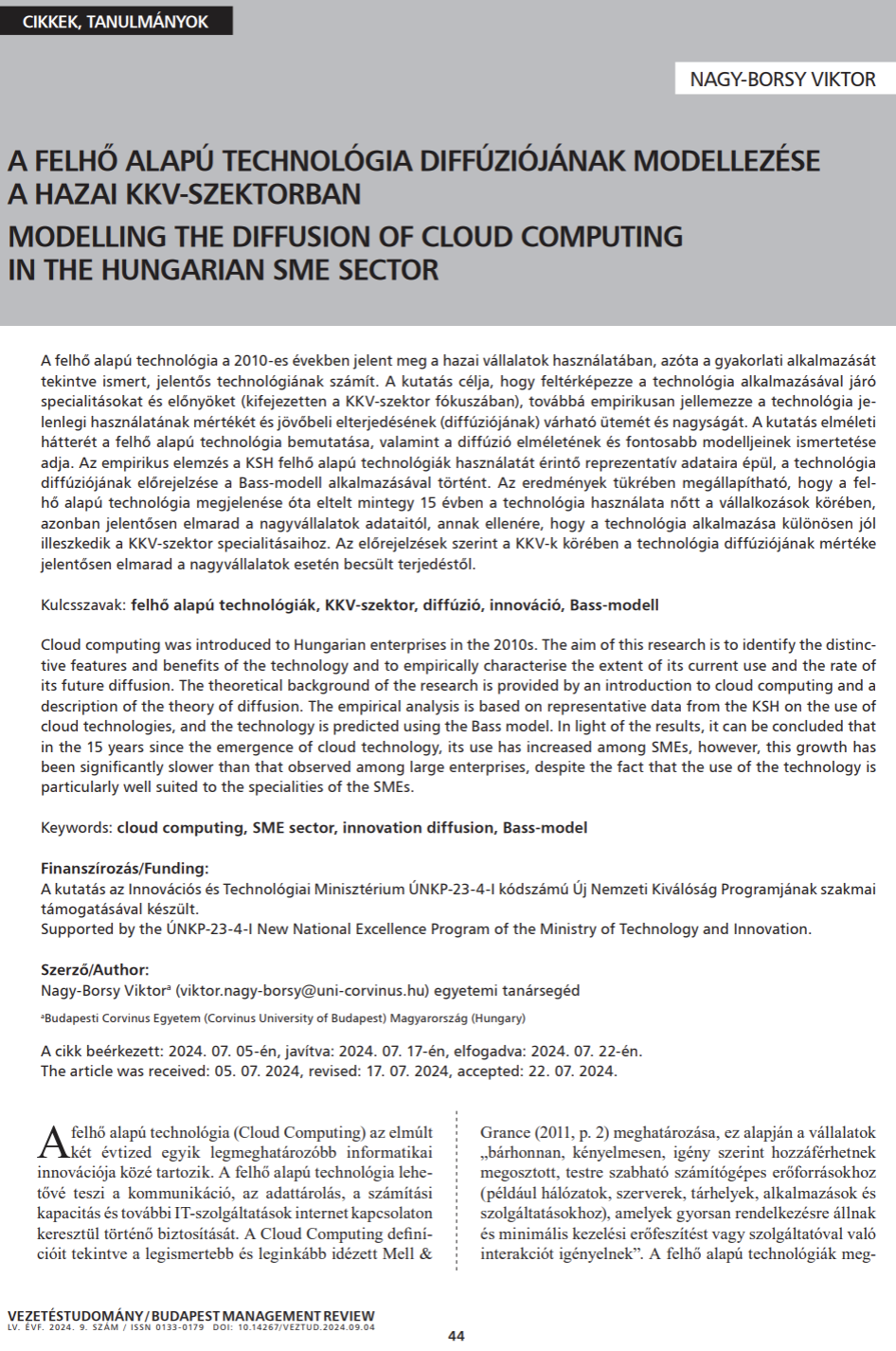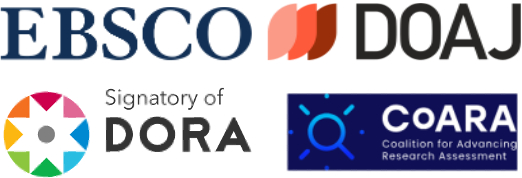A felhő alapú technológia diffúziójának modellezése a hazai KKV-szektorban
DOI:
https://doi.org/10.14267/VEZTUD.2024.09.04Kulcsszavak:
felhő alapú technológiák, KKV-szektor, diffúzió, innovációAbsztrakt
A felhő alapú technológia a 2010-es években jelent meg a hazai vállalatok használatában, azóta a gyakorlati alkalmazását tekintve ismert, jelentős technológiának számít. A kutatás célja, hogy feltérképezze a technológia alkalmazásával járó specialitásokat és előnyöket (kifejezetten a KKV-szektor fókuszában), továbbá empirikusan jellemezze a technológia jelenlegi használatának mértékét és jövőbeli elterjedésének (diffúziójának) várható ütemét és nagyságát. A kutatás elméleti hátterét a felhő alapú technológia bemutatása, valamint a diffúzió elméletének és fontosabb modelljeinek ismertetése adja. Az empirikus elemzés a KSH felhő alapú technológiák használatát érintő reprezentatív adataira épül, a technológia diffúziójának előrejelzése a Bass-modell alkalmazásával történt. Az eredmények tükrében megállapítható, hogy a felhő alapú technológia megjelenése óta eltelt mintegy 15 évben a technológia használata nőtt a vállalkozások körében, azonban jelentősen elmarad a nagyvállalatok adataitól, annak ellenére, hogy a technológia alkalmazása különösen jól illeszkedik a KKV-szektor specialitásaihoz. Az előrejelzések szerint a KKV-k körében a technológia diffúziójának mértéke jelentősen elmarad a nagyvállalatok esetén becsült terjedéstől.
Letöltések
Hivatkozások
Abdollahzadegan, A., Hussin, A.R.C., Gohary, M.M. & Mahyar, A. (2013). The Organizational Critical Success Factors for Adopting Cloud Computing in SMEs. Journal of Information Systems Research and Innovation (JISRI), 4(1), 67-74. https://seminar.utmspace.edu.my/Jisri/download/G_FinalPublished/Pub8_CSF_CloudComputingSME.pdf
Alshamaila, Y., Papagiannidis, S. & Li, F. (2013). Cloud computing adoption by SMEs in the north east of England: A multi‐perspective framework. Journal of Enterprise Information Management, 26(3), 250-275. https://doi.org/10.1108/17410391311325225
Amazon Web Services (2006). AWS Cloud Adoption Framework. Amazon.com, Inc. https://aws.amazon.com/cloud-adoption-framework/
Armbrust, M., Fox, A., Griffith, R., Joseph, A.D., Katz, R., Konwinski, A., Lee, G., Patterson, D., Rabkin, A., Stoica, I., & Zaharia, M. (2010). A View of Cloud Computing. Communications of the ACM, 53(4), 50-58. https://doi.org/10.1145/1721654.1721672
Assante, D., Castro, M., Hamburg, I. & Martin, S. (2016). The Use of Cloud Computing in SMEs. Procedia Computer Science, 83, 1207–1212. https://doi.org/10.1016/j.procs.2016.04.250
Bak, G., & Reicher, R. (2022). Challenges of the SMEs in the 21st Century. Scientific Papers of Silesian University of Technology, 166, 31-47. https://doi.org/10.29119/1641-3466.2022.166.3
Bass, F.M. (1969). A new product growth model for consumer durables. Management Science, 15(5), 215-227. https://doi.org/10.1287/mnsc.15.5.215
Bemmaor, A.C. (1992). Modeling the Diffusion of New Durable Goods: Word-of-Mouth Effect Versus Consumer Heterogeneity. In Laurent, G., Lilien, G.L., & Pras, B. (Eds.), Research traditions in marketing. International Series in Quantitative Marketing, vol 5. (pp. 201-229). Springer. https://doi.org/10.1007/978-94-011-1402-8_6
Bőgel, Gy. (2009). Az informatikai felhők gazdaságtana – üzleti modellek versenye az informatikában. Közgazdasági Szemle, 56(július–augusztus), 673–688. https://dea.lib.unideb.hu/server/api/core/bitstreams/72e53b11-f9e6-44d1-b885-4e39b571f256/content
Chou, T. (2010). Introduction to Cloud Computing: Business & Technology. Active Book Press.
Dempsey, D. & Kelliher, F. (2018). Industry Trends in Cloud Computing. Alternative Business-to-Business Revenue Models. Palgrave Macmillan. https://doi.org/10.1007/978-3-319-63994-9
Endrődi-Kovács, V., & Stukovszky, T. (2022). The adoption of Industry 4.0 and digitalisation of Hungarian SMEs. Society and Economy, 44(1), 138-150. https://doi.org/10.1556/204.2021.00024
Epstein, J.M. (2006). Generative Social Science: Studies in Agent-Based Computational Modeling. Princeton University Press.
Eurostat (2023). Cloud computing services by size class of enterprise. Code: isoc_cicce_use. https://ec.europa.eu/eurostat/databrowser/view/isoc_cicce_use/default/table?lang=en
Floyd, A. (1962). Trend Forecasting: A Methodology for Figure of Merit. In Bright, J. (Ed.), Technological Forecasting for Industry and Government: Methods and Applications (pp. 95-105). Prentice-Hall.
Fisher, J.C. & Pry, R.H. (1971). A simple substitution model of technological change. Technological Forecasting and Social Change, 3, 75-88. https://doi.org/10.1016/S0040-1625(71)80005-7
Fourt, L.A., & Woodlock, J.W. (1960). Early Prediction of Market Success for New Grocery Products. Journal of Marketing, 25, 31-38. https://doi.org/10.1177/002224296002500206
Füzes, P. (2019). Bomlasztó innováció-e a felhőalapú szolgáltatás? Vezetéstudomány, 50(2), 1-13. https://doi.org/10.14267/VEZTUD.2019.02.01
Geroski, P.A. (2000). Models of technology diffusion. Research Policy, 29(4-5), 603-625. https://doi.org/10.1016/S0048-7333(99)00092-X
Hethcote, H.W. (2000). The Mathematics of Infectious Diseases. SIAM Review, 42(4), 599-653. https://doi.org/10.1137/S0036144500371907
Jackson, M.O., & Zenou, Y. (2014). Games on networks. In Handbook of Game Theory with Economic Applications, Vol. 4 (pp. 95-163). Elsevier. https://doi.org/10.1016/B978-0-444-53766-9.00003-3
Kavis, M.J. (2015). Architecting the Cloud: Design Decisions for Cloud Computing Service Models (SaaS, PaaS, and IaaS). John Wiley & Sons Inc.
Központi Statisztikai Hivatal (2015). Módszertani dokumentáció/ adatgyűjtések. Az információs és kommunikációs technológiák állományának minőségi és mennyiségi adatai. https://www.ksh.hu/apps/meta.objektum?p_lang=HU&p_menu_id=1120&p_ot_id=1100&p_obj_id=1840_2015&p_session_id=57280539
Központi Statisztikai Hivatal (2017). Gazdasági szervezetek IKT-használati mutatói. https://statinfo.ksh.hu/Statinfo/haDetails.jsp?query=kshquery&lang=hu
Központi Statisztikai Hivatal (2020). Az információs és kommunikációs technológiák állományának minőségi és mennyiségi adatai 2020. https://www.ksh.hu/docs/hun/info/02osap/2020/kerdoiv/k201840.pdf
Központi Statisztikai Hivatal (2023). Vállalkozások IKT használata a foglalkoztatottak száma szerint. https://statinfo.ksh.hu/Statinfo/haViewer.jsp
Mahajan, V., Muller, E., & Bass, F.M. (1990). New product diffusion models in marketing: A review and directions for research. Journal of Marketing, 54(1), 1-26. https://doi.org/10.2307/1252170
Mahajan, V., Muller, E., & Bass, F.M. (1995). Diffusion of New Products: Empirical Generalizations and Managerial Uses. Marketing Science, 14(3), 79–88. https://doi.org/10.1287/mksc.14.3.G79
Mahajan, V., Muller, E. & Wind, Y. (2000). New Products Diffusion Models, Springer Science and Media, Inc.
Mahajan, V., & Peterson, R.A. (1985). Models for Innovation Diffusion. Sage Publications. https://doi.org/10.4135/9781412985093
Mansfield, E. (1961). Technical change and the rate of imitation. Econometrica, 29(4), 741-766. https://doi.org/10.2307/1911814
Marston S., Li, Z., Bandyopadhyay, S., Zhang, J., & Ghalsasi, A. (2011). Cloud computing – The business perspective. Decision Support Systems, 51(1), 176-189. https://doi.org/10.1016/j.dss.2010.12.006
Mell, P. & Grance, T. (2009). The NIST Definition of Cloud Computing. National Institute of Standards and Technology, Information Technology Laboratory, Gaithersburg, Maryland, Technical Report Version 15. https://nvlpubs.nist.gov/nistpubs/Legacy/SP/nistspecialpublication800-145.pdf?lspt_context=gdpr
Mell, P. & Grance, T. (2011). The NIST Definition of Cloud Computing. Recommendations of the National Institute of Standards and Technology. National Institute of Standards and Technology. Gaithersburg. https://doi.org/10.6028/NIST.SP.800-145
Nagy, J., Oláh, J., Erdei, E., Máté, D., & Popp, J. (2018). The role and impact of Industry 4.0 and the internet of things on the business strategy of the value chain—the case of Hungary. Sustainability, 10(10), 3491. https://doi.org/10.3390/su10103491
Nemeslaki, A. & Sasvári, P. (2015). A felhőalapú számítástechnika használata a köz- és üzleti szférában. Pro Publico Bono – Magyar Közigazgatás, 4, 76-84. https://real.mtak.hu/33740/1/PPB_15_4_felho_u.pdf
Newman, M.E.J. (2010). Networks: An Introduction. Oxford University Press.
Norton, J. A., & Bass, F.M. (1987). A diffusion theory model of adoption and substitution for successive generations of high-technology products. Management Science, 33(9), 1069-1086. https://doi.org/10.1287/mnsc.33.9.1069
OECD (2023). CT Access and Usage by Businesses. https://stats.oecd.org/Index.aspx?DataSetCode=ICT_BUS#
Orova L. (2006). Az innováció terjedésének modellezése. Marketing & Menedzsment, 40(2-3). 18-31. https://journals.lib.pte.hu/index.php/mm/article/view/747
Orova, L. (2010). Az új termék elterjedési modellek üzleti alkalmazásának módszertani kérdései (Doktori értekezés). Szent István Egyetem Gazdálkodás- és szervezéstudomány Doktori Iskola. https://archive2020.szie.hu/file/tti/archivum/Orova_Laszlone_tezis.pdf
Palos-Sanchez, P.R. (2017). Drivers and barriers of the cloud computing in SMEs: the position of the European union. UNIE Business Research, 6(2), 116–132. https://doi.org/10.3926/hdbr.125
Racskó, P. (2012). A számítási felhő az Európai Unió egén. Vezetéstudomány, 43(1), 2-16. https://doi.org/10.14267/VEZTUD.2012.01.01
Rogers, E.M. (1962). Diffusion of Innovations. Free Press.
Rogers, E.M., & Shoemaker, F.F. (1971). Communication of Innovations: A Cross-Cultural Approach. Free Press.
Ross, P.K. & Blumenstein, M. (2015). Cloud computing as a facilitator of SME entrepreneurship. Technology Analysis & Strategic Management, 27(1), 87-101. https://doi.org/10.1080/09537325.2014.951621
Sultan, N.A. (2011). Reaching for the “cloud”: How SMEs can manage. International Journal of Information Management, 31(3), 272-278. https://doi.org/10.1016/j.ijinfomgt.2010.08.001
Schumpeter, J.A. (1980) A gazdasági fejlődés elmélete. Közgazdasági és Jogi Kiadó.
Szabó, Gy., Benczúr, A. & Molnár, B. (2013). ERP-rendszerek a számítási felhőben (cloud computing): A felhőtechnikával összefüggő új ERP kiválasztási kritériumok elemzése. Vezetéstudomány, 44(11), 62-68. https://doi.org/10.14267/VEZTUD.2013.11.06
Szakály, D. (2008). Innováció- és technológiamenedzsment. Bíbor Kiadó.
Wei, Y. & Blake, M.B. (2010). Service-Oriented Computing and Cloud Computing: Challenges and Opportunities. IEEE Internet Computing, 14(6), 72-75. https://doi.org/10.1109/MIC.2010.147

Downloads
Megjelent
Hogyan kell idézni
Folyóirat szám
Rovat
License
Copyright (c) 2024 Copyright (c) 2024 Corvinus University of Budapest, publisher of Vezetéstudomány / Budapest Management Review

This work is licensed under a Creative Commons Attribution 4.0 International License.
Authors assign copyright to Vezetéstudomány / Budapest Management Review. Authors are responsible for permission to reproduce copyright material from other sources.

